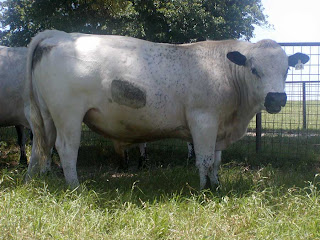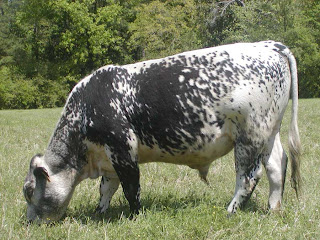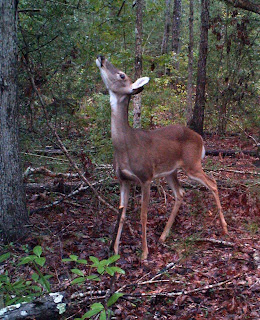When one reads the description of this breed and views photos of examples of the breed, you could just as easily be reading a description of the polled British White cattle breed, with the exception of color standards. This breed embraces both the overmarked (linebacked), the roan (leopard) type, as well as the white Speckled Park. In the British White breed we see all three types born in our herds, but focus on the white type, rather than breeding for a predominance of line-backed cattle. The photos you see here are of British White cattle exhibiting the same color patterns of the Speckle Park breed. With the exception of the example of the 'leopard' or 'roan' hair coat, all pictured are American Fullblood British Whites. The roan example is a 2nd Gen purebred heifer named Bluebell. She calved a snow white, perfectly marked heifer calf this spring, and I don't expect to see the roan pattern occur again in the offspring of this new 3rd Gen Purebred heifer.
The Speckle Park breed was formally recognized as a Purebreed by the Canadian Minister of Agriculture only as recent as 2006. In the preceding many years, the breed's owners were hard at work "stabilizing, refining, and perfecting the breed", and thus establishing seedstock that will breed true to type for those qualities important to the survival of all cattle breeds - superior confirmation and carcass quality. The docile nature and maternal excellence of the foundation seedstock was undoubtedly not difficult to perpetuate, as those traits are highly heritable in the polled British White, once known as the polled Park, or polled White Park.
The following is excerpted from the very well written description of the traits of the Speckle Park cattle breed found at this link :
Speckle Park cattle come in a variety of color patterns. They are predominantly black with white top line and underline, with speckled hips and sometimes shoulders and with a black or black roan face. The second color pattern is the leopard pattern. It is similar to the speckled pattern but there are definite black spots on the animal instead of just speckles. The white animals with some black hair on the body are considered 'leopards'.
The following is excerpted from the very well written description of the traits of the Speckle Park cattle breed found at this link :
 |
| British White Heifer, Purebred, Roan Markings |
 |
| Overmarked AF British White Cow w/Standard Marked Heifer |
 |
| British White Bull, J.West's Big Mac |
With their fine skin and hair in summer and a quick to 'slick off' hair coat, Speckle Parks adapt well to the Canadian summers as well as being able to 'coat up' when needed for their notoriously cold winters. They are tough, real tough, you can throw any harsh climatic situation at them and they survive, get back in calf, rear a good one, yet are so easy to feed and come back in condition quickly after hard times, traits that will stand them in good stead in Australian's harsh environment.
High Quality Carcass
In Canada butchers and meat graders are very impressed with the consistently high quality of the Speckle Park carcass. It isn't uncommon to get an exceptionally good carcass from any breed, but what is IMPRESSIVE is when the carcass from a particular breed is consistently good. That is the case with the Speckle Park. Another IMPRESSIVE fact about the Speckle Park is their UNIQUE ability of being able to achieve a AAA carcass without excess outer fat cover. Most breeds are able at achieve AAA carcass but often at the expense of excess outer fat. Speckle Park can achieve a AAA carcass with minimal fat cover, thus grading YG1-AAA.
Docile Nature
The key to more weight gain and less stress on man and beast. Are you sick of being kicked from pillar to post and pushed around the yards when you should be doing the pushing?
Speckle Parks are very docile animals. Their gentle disposition makes them a pleasure to work with. Accidents while working with cattle are almost unheard of among Speckle Park breeders. A well known fact in Canada.
Speckle Park animals are becoming a popular choice of 4-H beef members (Junior Breeders) throughout Canada. Their moderate size and quiet disposition make them manageable by even the youngest 4-H members. It is unbelievable how easily some of them halter break. As one 4-H member put it, "They almost halter break themselves."
Calving Ease and Good Maternal Instinct
Speckle Park rarely experience difficulty calving. The small front shoulders of the newborn calf make for calving ease. The calves come into the world at approximately 35kg. and are very vigorous at birth. Most newborns are up and sucking in minutes.
Cattlemen world wide know that a great deal of time and expense is saved and the bottom line is greatly enhanced by breeding cattle that can calve unassisted. It isn't uncommon in today's society to see the wife caring for the cattle while the husband works off the farm to supplement farm income. Speckle Parks are a wise choice for farmers in this situation. The calves weigh a fraction of the weight of those of the exotic breeds and a lot less than most other British bred cattle. Almost all Speckle Park cows, even the heifers, calve unassisted.
Speckle Parks are a docile breed, the cows are very maternal when it comes to caring for their young. They have good udders, with many people commenting on their great udder, teat shape and length of teats. They turn off sappy well grown calves from a young age.
 |
| American Fullblood British White Bull |




